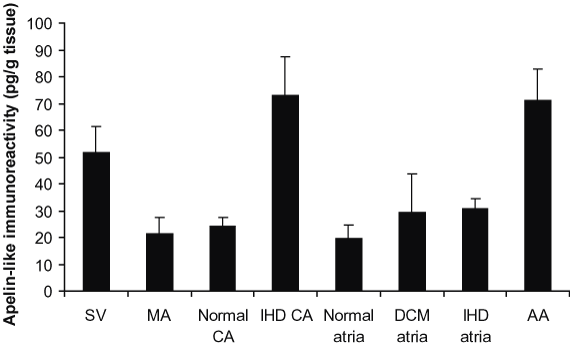143P Brighton
Winter Meeting December 2007 |
Identification and measurement of endogenous apelin peptides in the human cardiovascular system
Sarah Pitkin, Janet Maguire, Michael Ashby, Rhoda Kuc, Anthony Davenport. University of Cambridge, Cambridge, United Kingdom.
Apelin-13, (Pyr1)apelin-13 and apelin-36 are endogenous ligands for the G-protein coupled receptor APJ. They modulate vascular tone (Kleinz et al., 2005a) and cardiac contractility in human tissues in vitro with comparable potency (unpublished data). We have previously shown APJ localised to human vascular endothelial cells, smooth muscle cells and cardiomyocytes and discovered apelin peptides in human endothelial cells (Kleinz et al., 2005b). Our aims were (1) to measure endogenous levels of apelins in human cariovascular tissues, (2) to investigate whether apelins are released by endothelial cells and (3) to determine which apelin peptide is predominant in human cardiac tissue.
Human tissues, plasma and human umbilical vein endothelial cell (HUVEC) supernatants were extracted using SepPac C18 cartridges. Apelin peptide levels were determined by radioimmunoassay (RIA) using anti-apelin-36 serum and [125I](Pyr1)apelin-13. Levels were expressed as mean pg/g wet mass or pg/ml supernatant or plasma ± S.E. mean. Extracted atria samples were subjected to reverse phase HPLC (RP-HPLC) and collected fractions were analysed using RIA and mass spectrometry. n-Values are the number of patients from whom tissues were obtained.
Apelin peptides were detected in human large diameter vessels, atrial tissue (Figure 1) and plasma (0.60±0.05pg/ml, n=4). There was a significant increase in apelin peptide levels in atherosclerotic human coronary artery compared to histologically normal coronary artery. Apelin peptides were detected at significantly higher levels in HUVEC supernatants compared to blank media (0.82±0.08pg/ml vs 0.19pg/ml, P<0.01 one sample t-test). Combined RP-HPLC, RIA and mass spectrometry showed that human atria contains (Pyr1)apelin-13 and not apelin-13.

Fig.1 Apelin peptide levels in human cardiovascular tissues. SV, saphenous vein; MA, mammary artery; CA, coronary artery; AA, atrial appendage; DCM, dilated cardiomyopathy; IHD, ischaemic heart disease. n-Values=5-6. *Significantly different from normal CA levels P<0.05 unpaired Student's t-test.
Apelin-13, (Pyr1)apelin-13 and apelin-36 have comparable potency and efficacy in human cardiovascular tissues in vitro, but the posttranslationally modified (Pyr1)apelin-13 is the only isoform yet detected in human atria, suggesting this may be the predominant isoform in vivo. Apelins are released by cultured human endothelial cells and apelin peptides were detected in human plasma at a level comparable to ET-1, suggesting it may act as an endothelium derived paracrine mediator of vascular tone and cardiac contractility. Upregulation of apelin peptides in atherosclerotic coronary artery suggests a role for apelin in atherosclerosis.
Kleinz et al., (2005a), Proceedings of the British Pharmacological Society at http://www.pa2online.org/abstracts/Vol3Issue2abst148P1.pdf
Kleinz et al., (2005b), Regulatory Peptides, 126, 233-240
|


